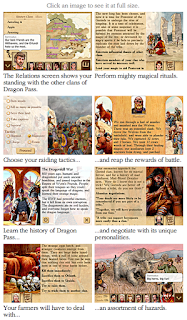Apple completely changed the mobile game business with the App Store. In the old days, game developers essentially sold their games to the mobile carriers, who would then add the title to the menus which were called “decks.” Navigation on most phones was pretty cumbersome, so if you weren’t in the first page of the menu, you didn’t get many sales because nobody would see your title. And, I use the term “title” on purpose, because the decks were text-only. Players had to choose your game solely on its title. This meant that many games were licensed, on the theory that if you liked Wheel of Fortune on TV, you’d like it on your phone. (Or at least you’d know what it was.) The App Store means that developers can sell directly to customers without a title-picking gatekeeper, and can use graphics (the icon and screen shots) and ad copy to help sell. (And you can do external marketing because you can link to the App Store.)
One feature of the App Store that resembles the old decks is the top 10 lists. Placement there can make a huge difference in sales. And people discovered that one way to get there was to be so cheap that your game is an impulse buy (increasing sales, which got you in the top 10, which meant you could stay in the top 10). So in a kind of prisoner’s dilemma, a race to the bottom began, and today many games sell for just a dollar or two.
It’s kind of odd for what are presumably the best products to be priced so cheap that people might buy them and forget to launch them. Because most of the time outside the App Store, price is loosely correlated with quality. Filet mignon costs more than hamburger — but it’s a better cut of meat. Normally, you expect a $4 product to be better than a $1 product, even if you aren’t in the mood to spend $4.
Of course, software costs money to create, and you need to sell an awful lot of it to recoup your investment if you’re only getting $1/copy (less Apple’s 30% cut). So not everyone sells for $1 (especially if a product isn’t of extremely broad appeal). Microeconomics suggests a smooth demand curve, where as price increases, sales decrease. I don’t think the App Store fits this model precisely. Not only is there the top 10 effect, but you need to price in increments of $1. And, the prices are all so low that there’s as much psychology as economics involved. Below some price, an app is an impulse buy. $1, $2, maybe even higher, is not a big barrier to purchase.
$1 is the lowest price, but are there any others that make sense? I’m heavily influenced by tech columnist
Andy Ihnatko, who discussed this in a talk. After closely following the App Store, he concluded that there are several sweet spots for pricing: $3, $5, and $10. Obviously you’ll have fewer customers pricing an app at $5 (compared to $4), but mostly you lose customers going from $3 to $4, so you might as well pick $5. $10 is notable as the highest price where an App Store listing alone is enough to sell someone — more than that and you will need some additional form of marketing
So what happens when you put these two factors (price = quality, special price points) together? I haven’t done a totally comprehensive survey of the App Store, but premium games are often $10 when new (and often more in iPad versions). When I first noted it, Chaos Rings was $10; it’s now down to $7 but Chaos Rings omega is $9. Final Fantasy III is $16, as is Final Fantasy Tactics.
And I certainly think of King of Dragon Pass as a premium game. There are no ads. It was designed for 40 hours of play, and insane repeatability. The artwork is really good. And many of the testers didn’t run into bugs at all. It’s also a single purchase — you’re not going to get nickel-and-dimed with in-app purchase. On the other hand, while it’s a great game, it may not be for all people — you actually need to read to enjoy it (even though I’ve seen a 3 year old choose to launch it multiple times).
There’s another important feature of the App store: ratings.
Apps that are impulse buys get a disproportionate number of 1-star ratings. Presumably people end up buying things they don’t actually like, and then take it out on the app. (This is even worse for free apps.) Andy Ihnatko claimed that ratings are one of the most important things people use when deciding to buy, so it’s worth thinking about how to avoid bad reviews from people who aren’t really your target market in the first place.
We thought about all this, and also ran it by our testers for confirmation (none of whom objected to our decision). We’ll start King of Dragon Pass at $9.99 (far less than it’s ever sold for before).
In summary, many games use price to say, “Look at me!” We’re using it to say, “This is an awesome game.”






